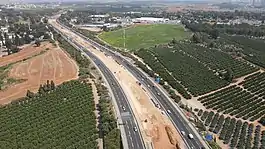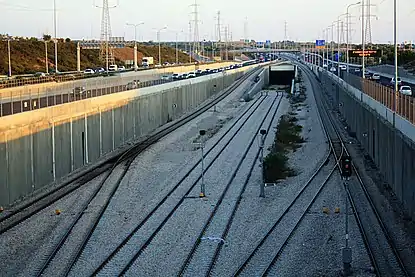| Rishon LeZion–Modi'in railway | ||||||||||||||||||||||||||||||||||||||||||||||||||||||||||||||||||||||||||||||||||||||||||||||||||||||||||||||||||||||||||||||||||||||||||||||||||||||||||||||||||||||||||||||||||||||||||||||||||||||||||||||||||||||||||||||||||||||||||||||||||||||||||||||||||||||||||||||||||||||||||||||||||||||||||||||||||||||||||||||||||||||||||||||||||||||||||||||||||||
|---|---|---|---|---|---|---|---|---|---|---|---|---|---|---|---|---|---|---|---|---|---|---|---|---|---|---|---|---|---|---|---|---|---|---|---|---|---|---|---|---|---|---|---|---|---|---|---|---|---|---|---|---|---|---|---|---|---|---|---|---|---|---|---|---|---|---|---|---|---|---|---|---|---|---|---|---|---|---|---|---|---|---|---|---|---|---|---|---|---|---|---|---|---|---|---|---|---|---|---|---|---|---|---|---|---|---|---|---|---|---|---|---|---|---|---|---|---|---|---|---|---|---|---|---|---|---|---|---|---|---|---|---|---|---|---|---|---|---|---|---|---|---|---|---|---|---|---|---|---|---|---|---|---|---|---|---|---|---|---|---|---|---|---|---|---|---|---|---|---|---|---|---|---|---|---|---|---|---|---|---|---|---|---|---|---|---|---|---|---|---|---|---|---|---|---|---|---|---|---|---|---|---|---|---|---|---|---|---|---|---|---|---|---|---|---|---|---|---|---|---|---|---|---|---|---|---|---|---|---|---|---|---|---|---|---|---|---|---|---|---|---|---|---|---|---|---|---|---|---|---|---|---|---|---|---|---|---|---|---|---|---|---|---|---|---|---|---|---|---|---|---|---|---|---|---|---|---|---|---|---|---|---|---|---|---|---|---|---|---|---|---|---|---|---|---|---|---|---|---|---|---|---|---|---|---|---|---|---|---|---|---|---|---|---|---|---|---|---|---|---|---|---|---|---|---|---|---|---|---|---|---|---|---|---|---|---|---|---|---|---|---|---|---|---|---|---|---|---|---|---|---|---|---|---|---|---|
 Railway construction north of Netzer Sereni (2020) | ||||||||||||||||||||||||||||||||||||||||||||||||||||||||||||||||||||||||||||||||||||||||||||||||||||||||||||||||||||||||||||||||||||||||||||||||||||||||||||||||||||||||||||||||||||||||||||||||||||||||||||||||||||||||||||||||||||||||||||||||||||||||||||||||||||||||||||||||||||||||||||||||||||||||||||||||||||||||||||||||||||||||||||||||||||||||||||||||||||
| Overview | ||||||||||||||||||||||||||||||||||||||||||||||||||||||||||||||||||||||||||||||||||||||||||||||||||||||||||||||||||||||||||||||||||||||||||||||||||||||||||||||||||||||||||||||||||||||||||||||||||||||||||||||||||||||||||||||||||||||||||||||||||||||||||||||||||||||||||||||||||||||||||||||||||||||||||||||||||||||||||||||||||||||||||||||||||||||||||||||||||||
| Status | Under construction | |||||||||||||||||||||||||||||||||||||||||||||||||||||||||||||||||||||||||||||||||||||||||||||||||||||||||||||||||||||||||||||||||||||||||||||||||||||||||||||||||||||||||||||||||||||||||||||||||||||||||||||||||||||||||||||||||||||||||||||||||||||||||||||||||||||||||||||||||||||||||||||||||||||||||||||||||||||||||||||||||||||||||||||||||||||||||||||||||||
| Owner | Israel Railways | |||||||||||||||||||||||||||||||||||||||||||||||||||||||||||||||||||||||||||||||||||||||||||||||||||||||||||||||||||||||||||||||||||||||||||||||||||||||||||||||||||||||||||||||||||||||||||||||||||||||||||||||||||||||||||||||||||||||||||||||||||||||||||||||||||||||||||||||||||||||||||||||||||||||||||||||||||||||||||||||||||||||||||||||||||||||||||||||||||
| Locale | Rishon LeZion, Ramla, Modi'in | |||||||||||||||||||||||||||||||||||||||||||||||||||||||||||||||||||||||||||||||||||||||||||||||||||||||||||||||||||||||||||||||||||||||||||||||||||||||||||||||||||||||||||||||||||||||||||||||||||||||||||||||||||||||||||||||||||||||||||||||||||||||||||||||||||||||||||||||||||||||||||||||||||||||||||||||||||||||||||||||||||||||||||||||||||||||||||||||||||
| Termini | ||||||||||||||||||||||||||||||||||||||||||||||||||||||||||||||||||||||||||||||||||||||||||||||||||||||||||||||||||||||||||||||||||||||||||||||||||||||||||||||||||||||||||||||||||||||||||||||||||||||||||||||||||||||||||||||||||||||||||||||||||||||||||||||||||||||||||||||||||||||||||||||||||||||||||||||||||||||||||||||||||||||||||||||||||||||||||||||||||||
| Stations | 6 (2 under construction) | |||||||||||||||||||||||||||||||||||||||||||||||||||||||||||||||||||||||||||||||||||||||||||||||||||||||||||||||||||||||||||||||||||||||||||||||||||||||||||||||||||||||||||||||||||||||||||||||||||||||||||||||||||||||||||||||||||||||||||||||||||||||||||||||||||||||||||||||||||||||||||||||||||||||||||||||||||||||||||||||||||||||||||||||||||||||||||||||||||
| History | ||||||||||||||||||||||||||||||||||||||||||||||||||||||||||||||||||||||||||||||||||||||||||||||||||||||||||||||||||||||||||||||||||||||||||||||||||||||||||||||||||||||||||||||||||||||||||||||||||||||||||||||||||||||||||||||||||||||||||||||||||||||||||||||||||||||||||||||||||||||||||||||||||||||||||||||||||||||||||||||||||||||||||||||||||||||||||||||||||||
| Opened | 2026 (estimated)[1] | |||||||||||||||||||||||||||||||||||||||||||||||||||||||||||||||||||||||||||||||||||||||||||||||||||||||||||||||||||||||||||||||||||||||||||||||||||||||||||||||||||||||||||||||||||||||||||||||||||||||||||||||||||||||||||||||||||||||||||||||||||||||||||||||||||||||||||||||||||||||||||||||||||||||||||||||||||||||||||||||||||||||||||||||||||||||||||||||||||
| Technical | ||||||||||||||||||||||||||||||||||||||||||||||||||||||||||||||||||||||||||||||||||||||||||||||||||||||||||||||||||||||||||||||||||||||||||||||||||||||||||||||||||||||||||||||||||||||||||||||||||||||||||||||||||||||||||||||||||||||||||||||||||||||||||||||||||||||||||||||||||||||||||||||||||||||||||||||||||||||||||||||||||||||||||||||||||||||||||||||||||||
| Line length | 30 km (19 mi) | |||||||||||||||||||||||||||||||||||||||||||||||||||||||||||||||||||||||||||||||||||||||||||||||||||||||||||||||||||||||||||||||||||||||||||||||||||||||||||||||||||||||||||||||||||||||||||||||||||||||||||||||||||||||||||||||||||||||||||||||||||||||||||||||||||||||||||||||||||||||||||||||||||||||||||||||||||||||||||||||||||||||||||||||||||||||||||||||||||
| Track gauge | 1,435 mm (4 ft 8+1⁄2 in) standard gauge | |||||||||||||||||||||||||||||||||||||||||||||||||||||||||||||||||||||||||||||||||||||||||||||||||||||||||||||||||||||||||||||||||||||||||||||||||||||||||||||||||||||||||||||||||||||||||||||||||||||||||||||||||||||||||||||||||||||||||||||||||||||||||||||||||||||||||||||||||||||||||||||||||||||||||||||||||||||||||||||||||||||||||||||||||||||||||||||||||||
| Electrification | 25 kV 50 Hz AC | |||||||||||||||||||||||||||||||||||||||||||||||||||||||||||||||||||||||||||||||||||||||||||||||||||||||||||||||||||||||||||||||||||||||||||||||||||||||||||||||||||||||||||||||||||||||||||||||||||||||||||||||||||||||||||||||||||||||||||||||||||||||||||||||||||||||||||||||||||||||||||||||||||||||||||||||||||||||||||||||||||||||||||||||||||||||||||||||||||
| ||||||||||||||||||||||||||||||||||||||||||||||||||||||||||||||||||||||||||||||||||||||||||||||||||||||||||||||||||||||||||||||||||||||||||||||||||||||||||||||||||||||||||||||||||||||||||||||||||||||||||||||||||||||||||||||||||||||||||||||||||||||||||||||||||||||||||||||||||||||||||||||||||||||||||||||||||||||||||||||||||||||||||||||||||||||||||||||||||||
The Rishon LeZion–Modi'in railway (also known as 431 railway and Sorek railway[2][note 1]) is a railway project under construction linking the cities of Rishon LeZion and Modi'in in central Israel. The project will form a part of Israel Railways' suburban rail network serving the Tel Aviv metropolitan area, as well as provide an east-west connection between the Tel Aviv–Ashkelon, Tel Aviv–Beersheba and Tel Aviv–Jerusalem rail corridors. The fully electrified line will be 30 km (19 mi) long, and involve the construction of two new train stations and Israel's longest railway viaduct.[1]
Works on the railway started in November 2019, and the project is scheduled to open in 2026 at an estimated cost of NIS 3.2 billion.[1]
History
Background
The line incorporates two small sections of existing infrastructure which were previously disjointed spur lines. The 3 km (1.9 mi) single-track Be'er Ya'akov–Rishon LeZion railway, which branched off the British-period Lod–Ashkelon railway and terminated at Rishon LeZion HaRishonim, opened in 2003.[3] The 7.5 km (4.7 mi) double-track Anava–Modi'in railway, a branch of the Tel Aviv–Jerusalem railway (which was only completed up to Ben Gurion Airport at the time), opened in segments between 2007 and 2008, terminating at Modi'in Center.[4]
In 2005, works began on the construction of Route 431, a limited-access freeway connecting Rishon LeZion with Modi'in.[5] Traffic lanes were built on either side of both the Be'er Ya'akov–Rishon LeZion and Anava–Modi'in railways, incorporating the existing rail tracks into the new highway median, in a manner similar to Ayalon freeway-railway in central Tel Aviv. The highway was additionally designed to accommodate a dual-track railroad in its median for much of its length, guaranteeing right-of-way to extend and connect these two sections and thus creating the potential for a new contiguous Rishon LeZion–Modi'in corridor.
Additionally, the Rishon LeZion Moshe Dayan–Yavne West section of the Tel Aviv–Bnei Darom railway, which opened in 2012, was also designed with provisions for a tunnel branching eastwards, to connect to the western end of the future Rishon LeZion–Modi'in line.
Planning
In 2010, plans for the construction of the Rishon LeZion–Modi'in railway were submitted to the Center District planning committee. Objections were submitted by 2012.[6]
In 2014, it was decided to re-route the western section of the railway, between Moshe Dayan and HaRishonim, which had been planned to run through the built-up area of Rishon LeZion along Rabin Avenue. Rishon LeZion municipality and residents were opposed to the construction of a train station close to residential neighbourhoods, prompting the rail line to be diverted outside the city.[7] Instead, the revised plan called for the line to run on a viaduct on the south side of Route 431, and the station which had been planned to service western Rishon LeZion and COMAS college was relocated to Me'uyan Sorek Business Park.
As such, the majority of the route east of HaRishonim was approved in 2014,[6] while the western HaRishonim–Moshe Dayan section was processed separately and approved in 2017.[8]
Construction
In December 2018, first tenders for the construction of the line were issued.[2] The first construction contract was awarded in September 2019 to Electra Infrastructures.[1] Construction works started in November 2019.
Contracts for other sections of the line were subsequently awarded to Solel Boneh,[9] Shikun & Binui,[10] and Danya Cebus[11] all throughout 2020.
Apart from laying approximately 30 km (19 mi) of new double tracks, the project also involves doubling the single-track section east of Rishon LeZion HaRishonim.
Twelve bridges at a total length of 6 km (3.7 mi) are being constructed for this line, including a single 3.5 km (2.2 mi) viaduct, which will be Israel's longest railway bridge upon completion. The project also includes 1 km (3,300 ft) of tunneling, with the longest tunnel at 450 m (1,480 ft) in length.[2][12]
Two new railway stations are being built as part of the project, Rishon LeZion Me'uyan Sorek and Ramla South. In addition, works are being carried out in Rishon LeZion HaRishonim to extend the station platforms.[2]
Works will be carried out to electrify the full length of the line[2] at 25 kV 50 Hz AC, to comply with the Tel Aviv–Ashkelon and Tel Aviv–Jerusalem railways.
Stations
The 6 stations of the line include four pre-existing stations which were built in previous years as part of separate railway lines.
Two brand new stations (marked †) will be built as part of the project, and at least one station (Rishon LeZion HaRishonim) will be significantly upgraded and expanded.[2]
| Station | Opened | Transfers | Location | |
|---|---|---|---|---|
| English | Hebrew | |||
| Rishon LeZion Moshe Dayan | ראשון לציון משה דיין | 2011 | Light Rail Red Line (planned) Light Rail Green Line (planned) |
Rishon LeZion |
| Rishon LeZion Me'uyan Soreq † | ראשון לציון מעוין שורק | 2026 (est.) | ||
| Rishon LeZion HaRishonim | ראשון לציון הראשונים | 2003 | HaRishonim Bus Terminal Metro M1 Line (planned) | |
| Ramla South † | רמלה דרום | 2026 (est.) | Ramla South Bus Terminal (planned) | Ramla |
| Pa'atei Modi'in | פאתי מודיעין | 2007 | Modi'in | |
| Modi'in Center | מודיעין מרכז | 2008 | Modi'in Central Bus Station | |
Operations
Israel Railways plans to run commuter services on the railway as part of a larger loop encompassing the Tel Aviv metropolitan area, and including the Sharon railway and Eastern railway. Frequency is planned to be 2 trains an hour for each direction, and double that following further expansions of the network.[12]
Israel Railways estimates that the railway will shorten travel times from Rishon LeZion to Modi'in from 60 to about 30 minutes, and carry 15,000 passengers per day.[12]
Notes
- ↑ Named after the Sorek stream, which flows from east to west and empties into the Mediterranean south of the railway. However, the same name is also occasionally applied to the old Jerusalem–Beit Shemesh railway, which runs along the stream in its upriver eastern section.
References
- 1 2 3 4 "Electra Infrastructures to build new Israeli line". Rail Journal. 13 September 2019. Retrieved 5 June 2021.
- 1 2 3 4 5 6 "Israel Railways issues tenders for Highway 431 railway". Globes. 2 December 2018. Retrieved 12 June 2021.
- ↑ "קו הרכבת ת"א-ראשל"צ ייפתח ב-15 בספטמבר; משך הנסיעה - 20 דקות" (in Hebrew). Haaretz. 13 June 2003. Retrieved 9 June 2021.
- ↑ "עוד תחנה בדרך ל"עיר העתיד"" (in Hebrew). Haaretz. 2 April 2008. Retrieved 10 June 2021.
- ↑ "Route 431" (in Hebrew). Israel Ministry of Finance. 24 August 2020. Accessed 10 June 2021.
- 1 2 "Rishonim–Anava Railway Plan" (in Hebrew). Israel Planning Administration. Accessed 11 June 2021.
- ↑ "הרכבת הכבדה לא תעבור בין השכונות המערביות בעיר" (in Hebrew). Rishon LeZion municipal spokesperson. 21 January 2014. Archived 7 December 2017 at the Wayback Machine.
- ↑ "Moshe Dayan–Rishonim Railway Plan" (in Hebrew). Israel Planning Administration. Accessed 11 June 2021.
- ↑ "שיכון ובינוי זכתה במכרז של 210 מיליון שקל להקמת מסילה לרכבת ישראל" (in Hebrew). The Marker. 26 March 2020. Retrieved 12 June 2021.
- ↑ "שיכון ובינוי זכתה במכרז של הרכבת לעבודות תשתית ב-390 מיליון שקל" (in Hebrew). Calcalist. 16 September 2020. Retrieved 12 June 2021.
- ↑ "Danya to build Me'uyan Sorek railway station". Globes. 4 November 2020. Retrieved 12 June 2021.
- 1 2 3 "רכבת ישראל: אלקטרה תשתיות נבחרה לבצע פרויקט בשווי 400 מיליון שקל" (in Hebrew). Port2Port. 10 September 2019. Retrieved 12 June 2021.

